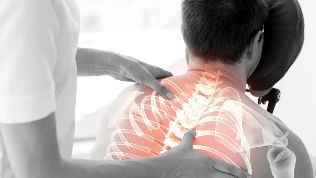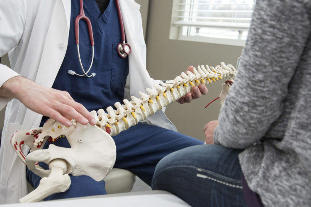Osteochondrosis is a collection of destructive changes of the spine, accompanied by damage and rapid destruction of the intervertebral discs. The last consist of cartilage, so easily succumb to the degeneration of the influence of the error of the load on the vertebrae. Osteochondrosis of the lumbar determined in patients of any age. But in the risk zone are included people older than 30 years, as well as patients, engaged in constant physical labor, sports.

One of the most expressed symptoms of the disease is a strong painful, accompanied by limitation of motion in the lumbar-sacral area. Often osteochondrosis is becoming a frequent complication of another disease of the skeleton, and it is fraught with serious consequences for the spine.
STAGE OF PROGRESSION OF THE DISEASE
Allocate four stages of progression of the degenerative disc disease of the lumbar spine:
- Characterized by erratic pain syndrome, manifested during the physical activity. Pain localized in the lower back and buttocks, may be tingling in these areas of the body.
- In the second stage can be diagnosed in the first significant destructive changes, to include the destruction of the fibrous rings, squeezing the nerves. Pain syndrome is manifested during physical exertion, becomes sharp and progressive. Patients experience relief at the slopes of the torso back.
- The progress of degradation of the fibrous rings leads to the destruction of cartilage and the formation of intervertebral hernia. The pain becomes constant and grows during physical activity.
- The cartilage of the fabric continues to decay, the affected sections of the spine arise from pathological growths, reducing the function of the skeleton. Reduces mobility and flexibility, pain syndrome is manifested constantly with varying intensity.
As usual, therapy is appropriate only the first stage of development of degenerative disc disease of the lumbar spine. Treatment in other situations, presents a summary of the measures, slowly decaying and increasing mental well-being of patients.
SIGNS AND SYMPTOMS OF DEFEAT
Feelings of pain in the lower back, which in slopes and other movements, are the first signs of the emergence of destructive disorders. Pain is indicative of destruction of the vertebral disc and squeezing the nerve endings. Another expressed symptoms:
- reduce the intensity of pain during the stay of the fuselage in a horizontal position;
- weakness in the lower extremities;
- numbness of feet, loss of tendon reflexes;
- curvature of the spine in the lower back left, right, lordosis and kyphosis.
In the later stages it is also possible incontinence of stool and urine. The pain arise even with minor exertion (e.g., coughing and sneezing). Complete and partial paralysis occurred in the inoperable degenerative changes.
Accompanied symptoms:
- numbness and tingling in the lumbar region;
- change the color of the skin in the buttocks, hips, lower back pain, darkening of the skin sheets;
- feeling of tension in the flexion and extension of the trunk;muscle atrophy and reduced activity (often arise as a complication of the disease);
- dryness and peeling of the skin cover;
- violation of sweating;
- vegetative disorders, caused by changes in the circulatory system, the downside of the supply of tissues with oxygen;
- the lack of (decreased) libido and sexual dysfunction.
Disorders of sensitivity occurred, as usual, directly on the hearth of defeat. While this is a possible hypersensitivity (increased), anesthesia (numbness) and paresthesia (feeling of tingling).
Most often disease find themselves exposed to the men, because they are more busy physical work. In this progression of disease is faster and the probability of the occurrence of sexual dysfunction is showing in several times higher than in women.
THE MAIN CAUSES AND RISK FACTORS
Osteochondrosis of the sciatic otdelaeshsya osteochondrosis, symptoms and treatment which is directly dependent on the stage of progression, often complicates the main causes of the occurrence. Not all of the assumptions and risk factors manage to remove in the therapeutic period. Accurately identify and define a summary of the reasons I can, not always.
In the list of the main causes of lumbar degenerative disc disease, the treatment of which may depend on their destination, are included:
- Uneven load on the spine, skeleton. Driven by upright posture and lack of physiological literate person. Uneven pressure characteristic for non-professional athletes and people who do heavy physical work.
- Increased loads. Even with the right approach to work the skeleton, the muscles and the spine is the possible destructive changes. During increased physical activity the vertebrae wear out faster, and changing, the cartilage disks are erased and gagging nerve endings. In such situations, it is in the first stages of the observed protrusion and hernia, which are then complicated pain sacral osteochondrosis, whose treatment is reduced to relieve the symptomatic manifestations and slowing further destruction.
- A bad posture. As usual, this phenomenon is accompanied by the incorrect distribution of the load on the spine, leading further to the destruction of bone and cartilage. In the risk group of older people, at which time there was a rapid decline in the elasticity of the intervertebral disc.
- A sedentary way of life. Often mated with inappropriate attitude and the uneven distribution of the load. In addition, changes can lead muscle gipotonus, caused by the lack of activity of muscles. In a constant sitting position the spine (especially the shoulders) loaded more than usual.
- Considerable excess weight. Every excess kilogram of body weight creates more pressure on the spine, causing destructive changes in the bone and cartilage. If obesity is accompanied by a sedentary lifestyle, the risk of developing needs in the treatment of lumbar-sacral spine, increases several times.
The basic causes can be risk factors that increase the likelihood of developing the disease and (or) accelerate its development. Among the main factors secrete:
- flat feet (due to the lack of function of the feet and the uneven distribution of pressure on the spine);
- the defeat of the digestive and cardiovascular systems;inflammatory processes of the bone and cartilage tissue, arthritis, osteoarthritis, osteomyelitis;
- a violation of hormonal background, diseases of the endocrine system;increased fatigue, violation of healthy biorhythm;
- frequent stress and disorders of the emotional condition.
- Doctors recommend to pay special attention to the lifestyle. Lack of sleep and stress, poor unbalanced diet more and more becoming the risk factors and catalysts of negative processes for the spine.
METHODS OF DETECTION AND IDENTIFICATION OF THE CAUSES OF
For the diagnosis to take place:
- medical history;
- the examination of the condition of the soft and hard tissues;
- laboratory tests.
At the first visit, the doctor performs a detailed inspection, determines the possible external manifestation of the disease, the availability of the curvature and the changes of the skin, sensitivity. In addition, when the primary examination, it is necessary to determine the localization of the pain syndrome. It is further held:
- Radiography. Is carried out in the side and rear projection. Allows to determine the presence and size of the lesions of the bones, to reveal the dimensions of the stands (depending on availability).
- Magnetic-resonance tomography. Allows you to specify the localization of the lesion using multi-angle visualization. Brings the destruction of soft tissues, inflammatory processes, damage to the nerve endings, blood vessels.
- Computed tomography. Like radiography, provides a visualization of the hard tissues of the spine and back. Allows you to more thoroughly consider the available destructive changes.
METHODS OF THERAPEUTIC EFFECTS
In osteochondrosis of the lumbar treatment is chosen individually. In the early stages is perhaps a conservative treatment with maintaining the normal health status of the patient. When severe destructive changes used surgery.
CONSERVATIVE METHODS
Seizures degenerative disc disease is often accompanied by severe pain, which cupping. With these goals used drugs:
- Analgesics. The most common are: Analgin, Deksalgin, Spazmalgon. Apply in sculptured form, and also in the form of injections.
- Chondroprotectors. Are not medicines, but they can maintain the elasticity of cartilage, to support the recovery of the damage. To a group of medicines include: Artifleks, Symptoms, Glucosamine.
- Non-steroidal anti-inflammatory drugs. The group includes: Diclofenac, Nimesulide, Ibuprofen. They help to relieve inflammatory processes and make it easier painful.
- Myotropic antispasmodics (Mydocalm). They are used to release muscle tension and alleviate pain syndrome.
Furthermore, applying anti-inflammatory creams and ointments (On the nimid, Traumeel, Dolobene, Finalgon). For pulling out the spine the pillar moreover manual therapy, massage and physical therapy. At home also the domestic application of therapeutic physical education.

When lumbar osteochondrosis symptoms and treatment medicines is required only upon the occurrence of severe pain and violation of the motility. Also, the drugs are needed for relief of the inflammatory processes and causes of disease.
SURGERY
When lumbar osteochondrosis symptoms and treatment in domestic conditions can be combined only in the early stages at low pain intensity and low negative manifestations of the disease. Surgical intervention is required when severe growths of bone tissue for the partial restoration of mobility of the skeleton. Also, using operation are removed intervertebral hernia, torn cartilage discs with a refund last.
FOLK REMEDIES
Folk remedies in osteochondrosis of the lumbar, symptoms, treatment and which are closely related, applies to mitigate the inflammatory process and pain syndrome. The most effective and safe:
- Pine bath. For the production of bathtubs it is necessary to give the water a pleasant temperature three to four sprigs of pine needles. The procedure is recommended to perform before going to sleep after a period of a quarter of an hour.
- Tincture of horseradish. In the same proportion, mix a tablespoon of vodka and the juice of fresh horseradish. Rub the painful stretches two-three times a day. After each treatment, to close the back of the blanket for warming.
- Leaf burdock. Clean the leaf of a plant hold it above the hot steam for ten minutes, then attach it to the affected area of the back. Wrap up the lower back a scarf or a blanket, leave on for one hour.
In therapy degenerative disc disease of the lumbar spine-symptoms and treatment it is important to match. It is not appropriate to use the recipes of folk medicine as an alternative to the main course. Home use of funds as an accessory.
PREVENTION AND RECOMMENDATIONS
Prevention of degenerative disc disease of the lumbar oldelpaso sciatic pain, symptoms, treatment and which are described above, in particular in the prevention. For the prevention of the disease is necessary to follow the instructions:
- evenly distribute the pressure on the skeleton and the spine, avoid intolerable physical work;
- to properly align the time for sleep and relaxation with physical exertion;
- attention to the technique of performing the exercises at a sport;
- use the rules for compilation of menu on the basis of the recommendations of a healthy diet;
- don't let excessive weight loss;
- undergo preventive checkups at the doctor and the neurologist, especially after 30 years;
- monitor hormone levels and to monitor the condition of the endocrine system;
- monitor the status of the posture and when you need to carry out therapeutic physical training, use massage and manual therapy.
RESULTS AND CONCLUSIONS
Are advancing in of the lumbar osteochondrosis – the result of improper distribution of the load on the spine, contempt for the rules for the formation of posture and technique of performing exercises in the sport. With age, the risk of disease for a given factor is increased by reducing the regenerative processes of bone and cartilage tissue. Treatment of degenerative disc disease is difficult, because the spine is not suitable for a complete recovery. Therefore, it is important to carry out prevention and to follow the recommendations of the attending physician.

















































